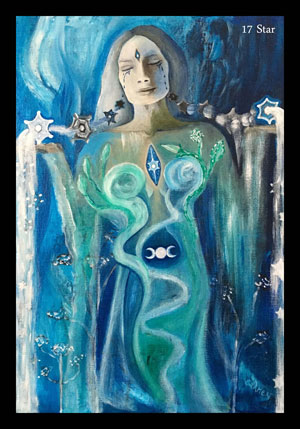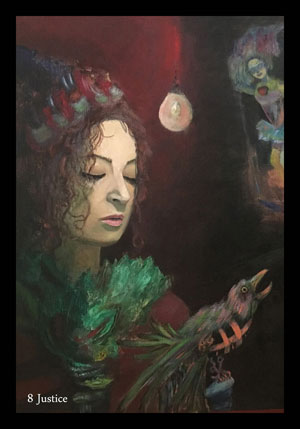 Diane Wilkes:
When did you first discover tarot? What were your experiences and first deck? What were/are your favorite decks?
Diane Wilkes:
When did you first discover tarot? What were your experiences and first deck? What were/are your favorite decks?
Carmen Sorrenti:
It seems funny to say: “I first discovered tarot as a fetus in my mother’s belly” but it is so. In Rome, there was a reader named Pina who privately read cards for a number of politicians. Pina told my mother that she was
pregnant and that the baby would be at great risk, but not to worry, to call her for guidance when it happened. Mom was only a few weeks pregnant, and since she lived alone in Positano with no telephone and far from roads, she was
really concerned at the prospect of this mysterious drama revolving ‘round her belly. Sure enough, shortly after the reading, she woke up in the night drenched in her own blood. She stumbled her way down the hill in pitch blackness
to get to a friend’s house as there is no hospital in town. Pina, true to her word, helped her through the crisis. A family member was a sculptor and they’ve transformed his studio into a café with all his larger-than-life looming
figures and casts—and, best of all, they put Pina’s deck in the masonry. I kept a reverent distance from tarot until much later when I started exploring decks in London. The next wave was work with the
Jodorowskys
using the
Marseille
Tarot. Probably the deck that has been the closest companion, the one I studied in great depth, is the
Mythic Tarot by Juliet Sharman-Burke and Liz Greene.
Because of its focus on myth, it has been a great inspiration
while I paint; I have listened to the accompanying audio over and over due to the stories involved. The cards took hold of me organically—I never felt I had to learn card meanings. The card characters became friends, companions
that are going through similar experiences. Every card is a process, the unfolding of a moment in a larger development. What is trying to happen in the soul…life doesn’t just hammer at us. To this day, when I see new cards, I get
flashes of what moments in Greek myth they belong to according to the Mythic Tarot deck. If the
Eight of Cups
appears,
Aphrodite
is close by with a set of seemingly impossible trials that, in fact, open up new terrain. I’m reminded of a verse by
John O’Donohue:
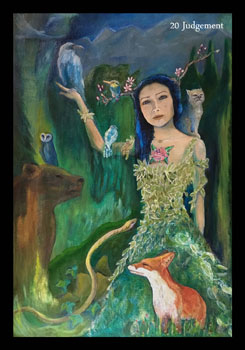 Until the veil of the unknown yields
Until the veil of the unknown yields
And something original begins
To stir toward your senses
And grow stronger in your heart...
Diane Wilkes:
What made you decide to create your own deck? Could you discuss the process of creation?
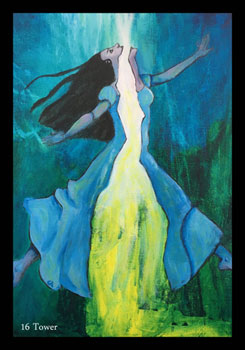 Carmen Sorrenti:
Carmen Sorrenti:
I had a series of dreams and visions over quite a long span of time and knew that these had a momentum towards something. We have a lot of direct experience of other realms but translation into this one is often where we fall
short and give up. I used to visit Tiber Island in Rome regularly. In the third century BC, they built a temple there dedicated to Asclepius. It was one of a series of temples where people would go to ask the God for healing
dreams. While I was there one afternoon, I had a brief and strongly experiential waking dream of priestesses burning herbs, creating a certain kind of enclosure for patients to feel an ecstatic dimension of their existence,
beyond the divisions of life and death. As far as I knew the Asclepian temples only had male priests, but I discovered through research that there were other cult places on the small island or nearby. Going into detail would be
lengthy and, in any case, it is not the literal dimension of this that matters, although apparently there was a house where women had a small apothecary right there... Anyway, it set me off and I needed to communicate something
from these places.
Diane Wilkes:
I know you’ve studied dreamwork with
Robert Moss,
and there’s a strong dream connection with the Pholarchos Tarot. Could you talk about that?
Carmen Sorrenti:
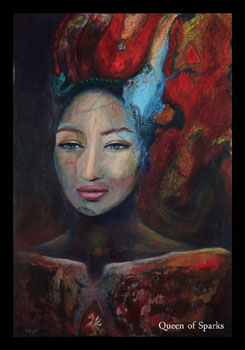
Moss is a great inspiration, he encourages people to have a very active relationship to dreaming. He has written several books on the subject, including one on the history of dream practices. He is an impressive storyteller and
has anecdotes from every time and culture. I have worked with many teachers, it is vital for me to see what different people have experienced—who you are will influence the kind of dreaming you encounter.
Charles Laughlin,
a neuro-anthropologist and former Tibetan monk (a tradition that puts much focus on dreaming) has written an extensive tome, Communing with the Gods, on dreaming around the world in different epochs. He made me realize that the
Pholarchos, under different names, have always existed. Other wonderful dream teachers I’ve studied with are
Ed Kellogg, Robert Waggoner,
and
Charley Morley.
I was also mentored and certified by
Scott Sparrow,
who has a practical
and profound method for building awareness of self as you dream. It is important not to treat dreams as passive films; dreams contain potent forces at work with whom one can build relationships, however you like to define them. I
suppose mine is a shamanic approach, and I believe life is naturally so. Everything is intelligent and the moment you pay attention, the world opens in unexpected ways. What will we do to conceal our vital force—and then what will
we do to try to reclaim it? I’m hoping such a deck of dream healers can inspire those who come across it to walk into those personal caves of limitless potential where dreams and visions lead the way through the labyrinth. The
deck is not about my dreams, although there are plenty of those in there. It is about dreaming, dreamers, waking dreams—the spaces in between and the cultivation of such spaces.
Diane Wilkes:
The
Pholarchos
is such a magical deck. What do you see its main purpose as a tarot deck? Are there specific themes you think work best with it?
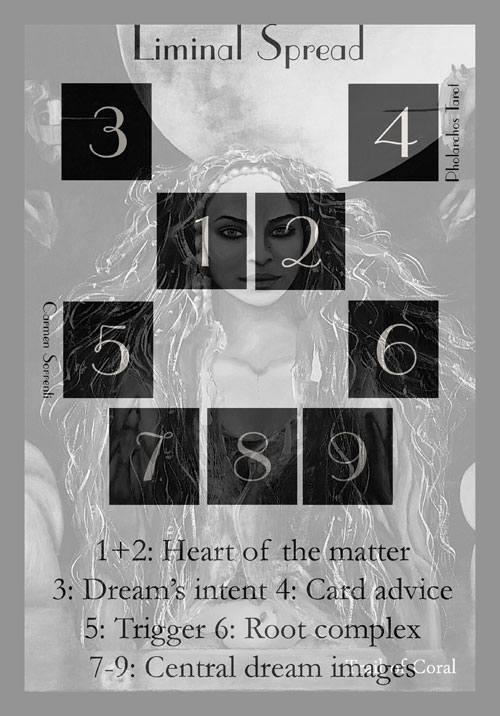 Carmen Sorrenti:
Carmen Sorrenti:
Thank you. There are 20 third eyes highlighted in the deck. According to some Tibetan beliefs, the soul incarnates through the pineal gland or third eye. I’ve come to see it as the liminal place in our bodies, the frontier. At
this crossroads, we are fertile for transformation; form is not fixed. In a lucid dream I once asked to be taken to the “true place of healing.” I was zoomed to a point of light in the center of my head. Is it the same place? It
makes you wonder . . . Perhaps images originate in the third eye before they become more concrete. There are many currents, both ancient and modern, that use images to do sacred work—the Imaginal is a bridge. Take the
Eight of Swords
—I have scrawled across it: “Negotiate your rebirth.” The figure is blurred with pain, but the infinity bird flies unimpeded in his brow. This is not simply positive thinking; the shadow in alchemy is the prima materia that
can become the gold. It has to be tended to, worked with lovingly—these bits of obstructed power and vitality are waiting to have a voice. We don’t want a volcano with a Band-Aid over it. A card is not a fate to simply swallow,
but a possibility for relationship and collaboration.
Diane Wilkes:
Your little white booklet is neither little nor typical—it’s very poetic. Was that a conscious choice?
Carmen Sorrenti:
No doubt. When I was 9 in the elementary school in Positano, we had a substitute teacher, Terminiello, who read poetry to us. This was unusual in our school and he decided to give it to us in installments, one stanza per lesson.
I couldn’t bear waiting so I convinced my friend to stay behind in the break to search his desk with me and find the Book, read the whole poem. The thing is, I didn’t understand a lot of the meaning behind the words, but something
in how he weaved the language had me in a spell. When language is linear, we can easily put it into a certain part of the brain that doesn’t necessarily surprise us and take us into unknown territory. We ‘get it’ and can quickly
file it away. Words need to haunt us, dig into new places, make us dream further. Sounds, juxtapositions, rhythms can do this in mysterious ways. Content does matter, that goes without saying but content may be noble, and the
writing still not move you.
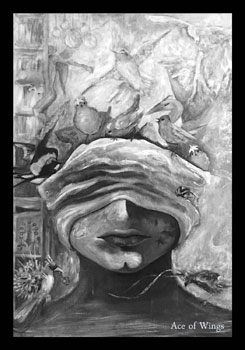 Diane Wilkes:
Diane Wilkes:
I noticed the booklet didn’t contain any spreads. Which spreads do you use most frequently? Have you created any Pholarchos-specific tarot spreads?
Carmen Sorrenti:
For some reason, I always come back to a version of the Celtic Cross. Something about it feels very complete. However, for seminars on using tarot with dreams, I have devised
the
"Liminal Spread”
(see diagram)
Diane Wilkes:
Diane: Do you have a particular favorite card or cards? What makes them special to you? Are they your favorite in all decks or just the Pholarchos?
Carmen Sorrenti:
I tend to fall in love with the cards I most need at any given moment because they are particularly relevant. Still, I guess I’d have to say the High Priestess in all decks, because she lights up the history around the Oracle
at Delphi for me. She is a tarot deck in herself. Imagine, this young woman on a tripod in a cave, inhaling gases from a crack in the Earth and having visions for humanity in a place named after ‘“delphus” or “womb.” And all this
taking place in a temple dedicated to both Apollo, god of light and logic, and Dionysos, god of ecstatic abandon—these two opposites had to share a worship space. It gives food for thought for how we make war in the world and the
inner wars of our ‘singular’ being. The inscription at the entrance reminds us over and over: “Know thyself,” which of course means all of yourself, not just what you like best or think is most presentable.
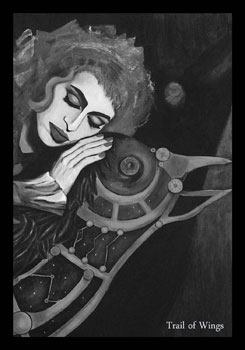
Diane Wilkes:
The
Trail (Knight)
cards and the
Aces
are greyscale, even though the original artwork is in full color. In the book, you call the Trail cards
psychopomps.
Do you see the Aces the same way?
Carmen Sorrenti:
The Aces and Trails (or Knights) are connected, yes. The Aces are the full potential of a suit before it is manifest—the full cornucopia coming out of the head without the ‘vision’ that sees it, color that defines it; there is no
separation downloaded into density yet, but still part of ‘One’ whole. There is an echo of Kabballah in the numbers, with the Ace being the One in potential, simmering with all life. We then move in color and complexity of
experience up the numbers until we reach the fully manifest 10, full color and with a focus on the eyes. There is no need to know the underlying structure to use the cards, but there had to be coherence for me while making them.
The Knights/Trails are messengers or guides to that world of the Aces. They are liminal figures and, as such, can take us quite far into other dimensions. Knights must always have missions, they are of service when they go out on
their quests. Here they serve safe passage in our deep travels, they know how to navigate the territory. Like in mythology, if you want to go to the Underworld you have to take the boat and pay the fee. There are several rules of
conduct; you can’t just go anywhere by wishing it—nor is it always advised. It is a useful metaphor for inner work. It doesn’t just happen willy-nilly, and one must tread carefully in certain regions. Dreams often warn us of areas
that are not ready to be opened.
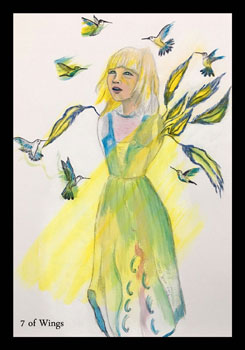 Diane:
Diane:
I love how you refer to reversals in the booklet as “hoodwinked”—would you care to explore that concept a bit?
Carmen Sorrenti:
Yes, I love it too! There is a bit of a joke about this now, because I was aware of the modern connotations of the word when choosing it—four times—in the booklet! I would like to start by saying that the original term, as far as
I know, just meant blindfold; since the deck draws quite a lot on ancient lore, I found it apt to encourage travel even in the language used. That said, I love the sound of the word. It is quite active, as if consciousness puts a
hood on you and winks, plays games. Mercury, who governs this realm in astrology, is quite the trickster. He got up to all sorts of mischief in myth, injecting spice and laughter into every episode. We have to be deft mind
acrobats if we are to catch him stealing cows and walking them backwards so as not to get in trouble with Apollo. Life does this all the time, as dreams do. Awareness needs to be very sharp and a sense of humor always comes in
handy. What is interesting is that in every culture you have a trickster god, be it Loki, Coyote, or Mercury. It is a vital function of consciousness… and it is handy to remember when considering the journey forward (or backward
as Mercury would have it!)
Diane Wilkes:
Lastly, what is the one thing you’d like to tell people who are using the Pholarchos?
Carmen Sorrenti:
There is such power and mystery in our being here. I hope the deck can be a reminder that through creativity and faith in our unfolding, the journey can be filled with awe. As I write this, a friend calls to tell me that she was
recently conscious in a dream, flying over incredibly beautiful landscapes. She was filled with gratitude to herself and to life for this experience. While she was flying, she suddenly thought: “Ah, Carmen is right then, it can
be this wonderful!” If the deck can encourage people into these states, then I am more than happy.
This interview by
Diane Wilkes
with Carmen Sorrenti was published in the
Cartomancer
magazine (Winter 2018). A
Pholarchos Tarot deck giveaway and Ms. Wilke's compelling
Review of this deck
are also anticipated to be in future Issues.
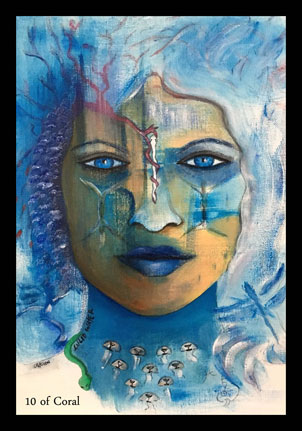
10 of Coral (Cups), Pholarchos Tarot
Please contact
publisher, distributor, Arnell Ando
for questions, comments & inquiries. Thank you!
Pholarchos Tarot is copyright protected.
Card images may be used on blogs/websites as 'Card of the Day' endeavors or for review purposes but must contain artist's
site
along with
Pholarchos Tarot by Carmen Sorrenti.
The images are not to form part of written teaching material or otherwise be used without prior consent from artist,
Carmen Sorrenti.

